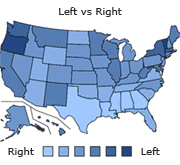A QUIZ OF COLOR

Color (American English) or colour (Commonwealth English) is the characteristic of human visual perception described through color categories, with names such as red, orange, yellow, green, blue, or purple. This perception of color derives from the stimulation of cone cells in the human eye by electromagnetic radiation in the spectrum of light. Color categories and physical specifications of color are associated with objects through the wavelength of the light that is reflected from them. This reflection is governed by the object's physical properties such as light absorption, emission spectra, etc.
By defining a color space, colors can be identified numerically by coordinates. The RGB color space for instance is a color space corresponding to human trichromacy and to the three cone cell types that respond to three bands of light: long wavelengths, peaking near 564580 nm (red); medium-wavelength, peaking near 534545 nm (green); and short-wavelength light, near 420440 nm (blue).[1][2] There may also be more than three color dimensions in other color spaces, such as in the CMYK color model, wherein one of the dimensions relates to a color's colorfulness).


